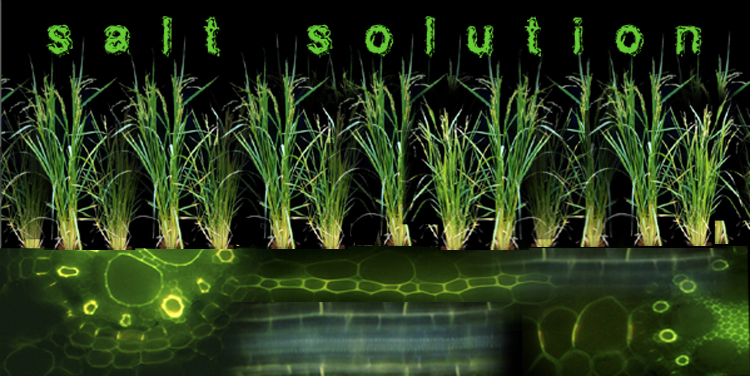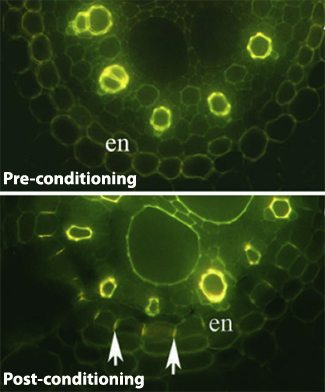Salt Solution

Rice plants (above) and their roots (below) stained with berberine aniline blue. Rice images from WikiCommons; Root images from paper cited in article. Design: Aathira Perinchery.

Before-and-after-conditioning photos of roots of the rice cultivar IR20. Exposure to a mild level of salt causes the walls of certain root cells to become impregnated with a waterproof wax (arrows). Water must now enter salt-filtering cells, which stop the salt reaching the plant's plumbing system (the xylem, the bright rings). Images from the cited paper.
Their method, developed using the salt-intolerant cultivar IR20, simply requires growing young rice plants for a week in a moderately high level of salt, about half that of the concentration that is toxic. This brief exposure, which they refer to as conditioning, "vaccinated" the plants: they would now survive if grown in what were previously toxic levels of salt.
The authors were also able to show how the tolerance to salt is increased. Conditioning shifts the balance between the two ways in which soil water can enter the plant's plumbing system (the xylem). Prior to conditioning much of the soil water that enters the xylem does so directly - it is thus unfiltered, and carries with it all the soil's dissolved compounds, both good and bad. After conditioning, a much greater proportion of soil water can only enter the xylem after having first crossed the plant's living tissues. These can filter out unwanted compounds - like salt. Shunting of water into the living tissues is primarily the job of a network of waxy, waterproof barriers (Casparian Bands) the most important of which are handily located around the inner core of the root, where the xylem is concentrated. Conditioning boosts the extent and effectiveness of this network, and this means that more of the plant's water ends up being filtered.
Filtering comes at a cost though. After conditioning, water moves through the plant more slowly, and the authors found that rice plants compensate by sprouting more roots. Whether these responses affect productivity is not yet known. But more importantly, the team was able to confirm that the roots that are triggered by conditioning are not leaky: they keep salt out too.
The authors also studied a second rice cultivar, Pokkali, which has a long history of success in areas suffering from salinity. They were able to show that its high salt-tolerance was due to it already having, without any need for conditioning, a filtering network of similar effectiveness to that which they saw after conditioning in IR20.
Overall, the study indicates that farmers will soon have much more choice in the cultivars they can grow on India's increasingly saline soils. And it tells scientists the characteristics they should focus on when they try to breed cultivars that are even more salt-tolerant.
* The article: "Root apoplastic barriers block Na+ transport to shoots in rice", (2011) J. Exp. Bot. doi: 10.1093/jxb/err135Pannaga Krishnamurthy1, Kosala Ranathunge2, Shraddha Nayak1, Lukas Schreiber2 and M.K. Mathew1
1. NCBS, Bangalore.
2. University of Bonn, Germany

Comments
Hello, The problem is
There are plants which
Kahara Lana is a rain fed
Post new comment